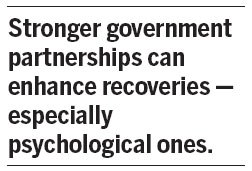 Large Medium Small
Large Medium Small
Yu Zhengyin spent 20 hours fighting to survive - but wanted to die once rescued.
She lost both legs when the 8.0-magnitude Wenchuan earthquake trapped her in a restaurant's rubble in the desolated Sichuan province in 2008, leaving her as one of more than 50,000 people disabled in the quake.
But Yu again cherishes life, largely thanks to Handicap International, which had helped more than 1,300 people disabled in the temblor when I met Yu in early 2011. Yu spoke to me while she and 26 other disabled survivors played a ball game in a support group the nongovernmental organization started in Mianzhu.
Days later, I talked with Plan International, whose projects helped schoolchildren overcome trauma. And last year, Tang Siqiong and Yang Fachun told me how they had resumed intimacy with their husbands after being paralyzed in the quake, since Handicap International and Caring for Children trained local doctors in sexual rehabilitation for spinal-cord injury patients.
These stories testify to nonprofits' potential in China's disaster zones and suggest stronger government partnerships can enhance recoveries - especially psychological ones.
Many lessons and structures that arose from the Wenchuan earthquake were physical - hence visible - such as reconstructed quake-resistant buildings.
Others are not as corporeal or conspicuous but still essential, such as rebuilt psyches.

I've witnessed firsthand the strengths of China's post-disaster response and reconstruction during 14 trips through the quake zone, in addition to two journeys through Qinghai province's Yushu quake region, Yunnan and Guizhou provinces' droughts and other catastrophe sites.
These include rapid mobilization during rescue, relief and reconstruction; effective infrastructure rebuilding, often including relocations to less susceptible areas; free media access; and partnerships among governments.
But governments' engagement of the nonprofit sector and trauma reduction remain among the least-understood legacies of post-Wenchuan relief.
Soon after Sichuan's disaster, I joined a newfound organization dedicated to improving education in the quake zone. Real growth began after we engaged the local government, especially Deyang city's education bureau.
The conclusion of our first trips in 2008 was that trauma remained the most tenacious obstacle - a specter our group was insufficiently qualified to deal with.
But nonprofits with that capacity entered later.
The principal told me last year that the children had recovered. Yet some teachers had not.
It may be because of age. Or it is perhaps because the children received rehabilitation and the adults had not.
I later founded a nonprofit to improve education in Yushu's quake zone.
While our regular projects include providing schools with solar panels, computers, 3G Wi-Fi, school materials, clothes and books in Qumalai county, we bought yaks for Yege Primary School after a March 2012 blizzard. The disaster killed more than half the livestock upon which the local nomads and students depend, since the average 4,300-meter elevation makes planting crops impossible.
Our greatest impact came last year, when we began direct cooperation with local governments.
This enabled us to put four solar panels in two schools and, on another campus, install a multimedia lab, music room, library and Internet-connected computer center.
While completing our 2013 projects, a small quake - the first since 2010 - jolted Qumalai county, rattling nerves but not even cracking buildings. The children's reactions showed they remained traumatized from the 2010 tremor that rendered one of their classroom buildings unusable. An international NGO was constructing a new building, which has since been completed.
Our volunteer group certainly is not equipped to treat trauma. No qualified experts have yet reached Qumalai's remote nomadic communities.
That is largely because of geography and geology.
But it is exactly because of geography and geology that China will continue to face natural disasters that inflict trauma.
The country's topography conspires against it.
China is the collision point of three tectonic plates that crumple more than two-thirds of its land into mountains. These folds are prone to quakes and avalanches of rock, earth and snow.
That is not to mention vast deserts and extreme elevations in the west also produce droughts, sandstorms and blizzards.
These landscapes also obstruct infrastructure, industry and agriculture, making inhabitants poorer and, therefore, less able to withstand the disasters they are more likely to endure. There is a roughly 90 percent overlap of the maps of China's geologically hazardous areas and of its poverty.
It is also internationally recognized that China is among the countries most vulnerable to climate change, which will multiply disasters and trauma.
China can better respond if governments more directly engage nonprofits, from international NGOs to grassroots groups.
All levels should proactively seek nonprofit involvement by directly inviting organizations to participate, exchanging information and co-funding projects.
Contact the writer at erik_nilsson@chinadaily.com.cn